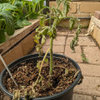Fusarium- with pix
beth11
18 years ago
More Discussions
Hi All,
Well, I've got some tomato plants fading fast from what I believe is
Fusarium (Carolyn- we've talked about this before. No it doesn't make sense
that all the plants are not affected. I just don't know what else it could
be). Fooey. New varieties this year that show yellow leaves (no spots),
wilting of one side of the plant - then the whole plant wilts- Convoluso
Genovese, Black from Tula, Marianna's Peace and Aunt Ginny's purple.
They'll need to be pulled. I do have a Convoluso, AGP and a MP that are in
different beds- doing OK so far. Eva Purple Ball, Carbon, Cherokee Purple,
Black Cherry, Sungold are fine. I've grown these before (except for Carbon)
and they seem to be resistant. They are planted right next to the affected
plants. I garden in 4' X 8' raised beds. I'm surprised at the Aunt
Ginny's purple- I have grown that one before. Anna Russian is looking wimpy
and hasn't set fruit, but no yellow leaves or wilting. I'll leave that one.
Anyone else having problems this year? I got back from traveling for work
and this is what I discover. They waited for me to leave, I guess. Double
Fooey.
Beth (in wilty southern MD)
Here is a link that might be useful: {{gwi:1299535}}

farkee
beth11Original Author
Related Professionals
Vernon Hills Landscape Architects & Landscape Designers · Medford Landscape Contractors · Andover Landscape Contractors · Concord Landscape Contractors · Fairfield Landscape Contractors · Paramus Landscape Contractors · Plantation Landscape Contractors · Saint George Landscape Contractors · Waltham Landscape Contractors · Whitehall Landscape Contractors · Bensenville Landscape Contractors · Annapolis Siding & Exteriors · Annapolis Siding & Exteriors · Enfield Siding & Exteriors · Framingham Siding & Exteriorsfarkee
DirtDigHer
carolyn137
Gimme3Steps
Sheila_GeorgiaPeach
farkee
farkee
beth11Original Author